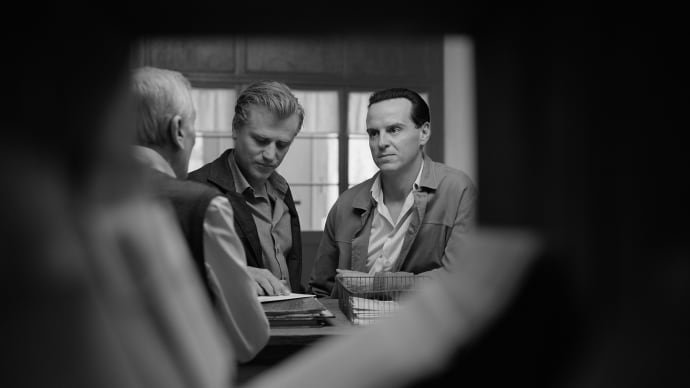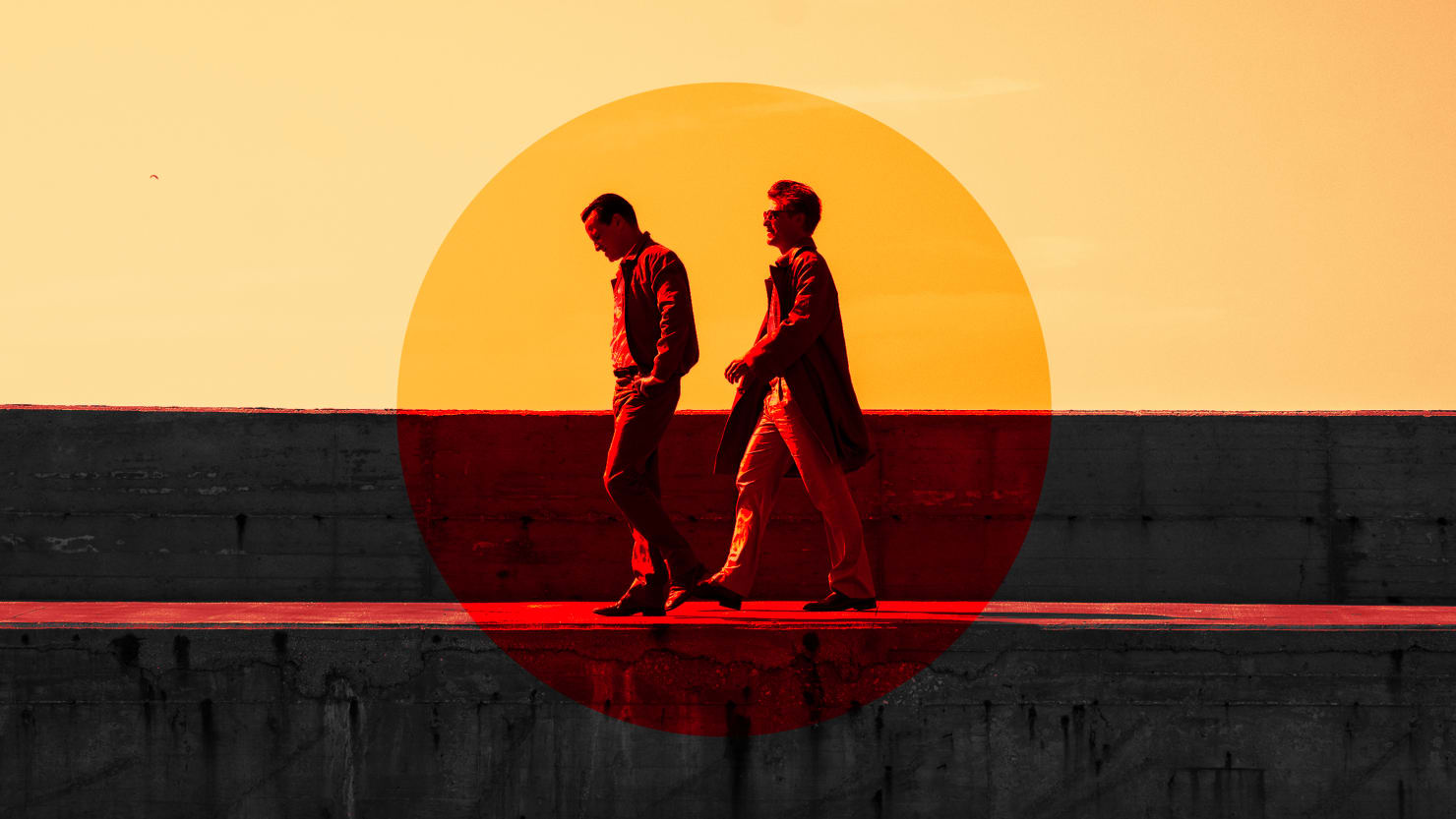Netflix’s Ripley, written and directed by Steven Zaillian (The Night Of, Schindler’s List), stars Andrew Scott as Tom Ripley, the loveable and mischievous (to put it gently) con man. Ripley is different from nearly anything else on Netflix—for one thing, it’s shot in black and white. But it’s also probably the single most exciting new show on the platform—and all other streamers—in 2024 thus far. And that unique sense of thrill can be distilled into one magnificent scene from Episode 3, “Sommerso.” It’s a brutal, beautiful showcase of a man with no limits, one of art’s most alluring antiheroes.
[Warning: Spoilers for Ripley below.]
At the start of “Sommerso,” Ripley is in Atrani, Italy, with Dickie Greenleaf (Johnny Flynn), who’s there with his girlfriend Marge Sherwood (Dakota Fanning). Ripley was sent there by Dickie’s parents, who have requested that he work to bring their son back to New York. But Ripley, having made a meal of his new life in Atrani, has no intention of returning to New York whatsoever. He reveals the plot to Dickie, who ends up inviting Ripley to stay with him.
While Dickie initially grows close to Ripley over the absurdity of Ripley’s presence in Dickie’s adopted homeland, both he and Marge have grown tired of his constant presence. After spending months together in Atrani, Dickie takes Ripley on a boat trip to Rome and, once they’re far out at sea, gently breaks the news that they know longer want him around—or, at least, as gently as one can deliver such harsh news.
The boat trip sequence is remarkable for several reasons. From its anxiety-inducing, climactic storytelling to its sublime cinematography, it’s the kind of scene you’d expect from a daring art-house film, not a Netflix series. That it involves Ripley’s turn from suspicious con man to outright sociopath makes it all the more unforgettable.
Johnny Flynn as Dickie Greenleaf and Andrew Scott as Tom Ripley.
Netflix
We’ve seen time and time again that two people out at sea is a recipe for death. It’s not so much that Ripley killing Dickie is surprising (especially if you’ve seen 1999’s The Talented Mr. Ripley or read Patricia Highsmith’s original novel). What’s shocking here is the effortlessness with which Ripley goes about murdering Dickie. There’s nothing impulsive about his decision to pick up the oar and bludgeon Dickie over and over in response to Dickie’s request for Ripley to leave town. But Dickie seems completely taken aback, with his last words a plea: “Tom, help me,” he asks his supposed friend. But he can barely get the sentence out before Ripley smashes him over the head a final time, ending Dickie’s life.
After killing Dickie, Ripley doesn’t appear overwhelmed. Instead, the show situates him in the center of the frame, showcasing his eerie sense of calm. Here, it becomes clear that this killing was not one of passion, but a deliberate next step in his mission—the purpose of that mission, however, is tantalizingly unclear. Most shows would cut away here, to Ripley back on land, perhaps nervously looking over his shoulder and watching his every move. But Ripley is just getting started.
Andrew Scott is terrifyingly brilliant in this role, and this scene exemplifies why. He perfectly captures Ripley’s coldness throughout the scene, appearing completely unfazed, as if he hasn’t just killed what anyone watching would consider his best friend. Scott’s physicality is alarming; his eyes flicker without remorse, his body rigid. This charming man is charming no more: This is a cold-blooded killer, and perhaps he always has been. It generates frightening questions in viewers’ minds—namely, how many people has Ripley killed in his lifetime to be so incredibly relaxed here?
For the next 15-odd minutes, we see Ripley’s considerable efforts to erase any evidence of his crime. He washes the blood off Dickie’s possessions and takes everything that could potentially identify him, slowly putting the next steps of his scheme into motion. Ripley’s typically excellent music and score are absent here for even more discomforting effect; the sequence unfolds in near silence, with only the sounds of the ocean—once relaxing, now unnerving—and the creaking of the boat to keep us at bay.
Things get complicated when trying to get Dickie’s body out of the boat. Ripley ties a rope around Dickie’s legs, attaching them to a heavy weight that’ll ensure he sinks to the bottom of the ocean, out of sight. But as the rope leaves the boat, it winds up tripping Ripley, launching him into the water and sending the motorboat in a circle around him.
It’s a nightmare situation, and the show stages it like one. When Ripley emerges from the water, there’s a look of panic on his face; it’s the first time we’ve seen him start to unravel, especially as we’ve learned by now that he’s unable to swim. Ripley narrowly avoids the boat smacking him in the face, only to have the weight he threw into the water bash him in the back of the head. The camera fades to black, and returns to find the boat still spinning around.

Johnny Flynn as Dickie Greenleaf and Andrew Scott as Tom Ripley.
Netflix
Miraculously, Ripley hasn’t drowned—and that this comes as a relief to us speaks to his disturbingly alluring nature. He grabs the rope and starts to climb it. His crotch is inches from the propeller, the sound of which creates an unbearable tension; but Ripley, the ever-lucky scoundrel, manages to avoid being sliced to death and finds himself back on the boat. He takes a moment to breathe, but only a moment. He snaps right back into action, finally throwing Dickie off the boat.
Any other show that hadn’t cut away when Dickie died certainly would by now. But Ripley is unyielding, as we see the con man head to shore and trash the boat. When fire doesn’t work, Ripley fills the boat with rocks to effectively drown it. After depositing hundreds of stones, Ripley then prepares to climb the tall cliffs to lead him back to Atrani—and, from there, taking over the newly deceased Dickie’s life. By showing us the entirety of Ripley’s plot to be rid of Dickie, the scene morphs into something infinitely more menacing than the typical shocking murder we see in dramatic film and television. It’s important to see Ripley kill Dickie, but it’s just as important that we see his dedication, and determination, to fulfill his destiny.
Up until now, we’ve had some idea of what Ripley is capable of. He’s schemed his way from New York to Italy, and he’s successfully embedded himself in Dickie and Marge’s life. It’s clear he’s an exceptionally capable con man who’s determined to accomplish a goal. But what we didn’t know is just how intense Ripley’s determination is, and the lengths that he’ll go to in order to get what he wants. This astonishing extended scene lays Ripley bare, exposing a man willing to kill to get the life he feels entitled to. But what’s really chilling about it all is how thorough he is—with each meticulous, extraordinary detail Ripley goes through to hide Dickie’s body and hide the boat, he becomes more transfixing and terrifying.
Episode 3 marks a clear turning point for the series, as it challenges everything we thought we knew about Ripley, while exposing just how much of a threat he really is. And it does it all without a single word. Other shows would kill for this kind of masterful, restrained, engrossing work.

Carol Dennis is an entertainment aficionado with an eye for all things pop culture. She dives into the glitz and glamour of the entertainment industry, from movie premieres to music festivals. Carol’s passion for storytelling extends beyond her reporting, as she’s an aspiring screenwriter in her free time.








